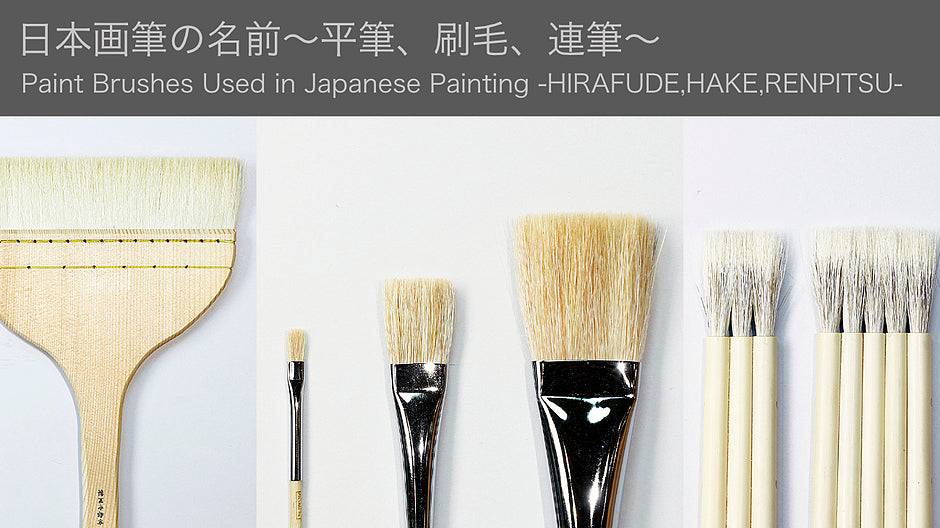In English, we usually say "brush" when we describe a brush, and although there are more detailed descriptions for different kinds of brushes, such as fine, round, flat etc., ultimately "brush" is the main term we use.
On the other hand, in Japanese, there are different words and vocabulary to name different kinds of brushes. For example, Umpitsu (運筆), Kotsugaki-fude (骨書筆), Menso-fude (面相筆), Kegaki-fude (毛書筆), technically they’re all rigger brushes for drawing fine lines, but they all come in several shapes and designs for different uses.
Furthermore, there are three main types of brushes for painting large surfaces: Hira-fude (平筆), Hake (刷毛) and Renpitsu (連筆).
Some of you might be familiar with or heard of them, but do you know what the differences are between them?
If don’t, no worries, the topic of this article will be focusing on these three brushes.
Hira-fude
Hira-fude (flat brush) is the most popular brush for painting flat surfaces. Many of you may have seen this type of brush in school or art class.
It has shorter bristles and is easier to use, making it suitable for painting a small area evenly.

It can be used not only with Sumi ink and animal glue but also with water-based paints like watercolors and acrylics, as well as oil-based paints.
It would not be too much to say that it is one of the most versatile types of brush that can be used on any medium and paint.
Here is a sample of how the result will look like by using the Hira-fude. From the top to the bottom, the color is drawn by increasing the amount of water.

【Brush】
・Gokuhin Flat Brush No.5
【Painting Surface】
・Bamboo Washi for Watercolor
【Paint】
・Saiboku Aya Kishu (Color Inkstick Yellow Vermillion)
Moreover, it is also possible to create a blurred effect with the unique brushstrokes of Hira-fude.
I highly recommend this type of brush for those who are new and want to have their first try on Hira-fude.
Hake
Hake (painting brush) is a brush with a flat tip that is commonly used for painting the entire surface.
Unlike a Hira-fude, it is not as flexible but is more suitable for painting large surfaces or base grounds.
Hake is often used at the beginning and end of the painting process for applying animal glue, sizing, priming, or the final varnishing.

Furthermore, it can be used with almost any kind of medium, either water-based or oil-based.
I personally recommend using a goat-hair brush for low viscosity paints and a nylon brush for high viscosity paints.
Needless to say, there are different hardnesses even for nylon brushes, so I’d say it’s better to try several kinds of Hake before starting on your artworks.
And here is a sample of how the result will look like by using the Hake.

【Brush】
・Kindei Brush No.10
【Painting Surface】
・Bamboo Washi for Watercolor
【Paint】
・Saiboku Aya Kishu (Color Inkstick Yellow Vermillion)
Compared to a Hira-fude, the bristles of Hake are more even and longer. Therefore, Hake has thinner bristles and is easy to apply paint , so you may want to consider buying one if you want to paint your work easily in one go, such as painting the ground or varnishing.
Renpitsu
I’m sure most of you have never seen a brush quite like this.
Renpitsu (bundled brush) forms like a shape and has almost the same width as Hake by combining several medium-sized round brushes. Therefore, it’s able to hold the paint well like a normal round brush and paint on a large surface like Hake.

Of course, other than the ability to hold paint well, Renpitsu is popular for being suitable at applying blurring effects and drawing steadily.
The reason for being able to create blurring effects is that the moisture came out from both ends of the bristles so they lighten out the colors, but since the Renpitsu absorbs the water in each bristle’s, so the paint can be applied evenly.
But to take full use of Renpitsu’s unique ability, it is best to use it with Sumi ink, animal glue, or watercolors.
For example, the Kataha Renpitsu (diagonal brush) for when your work is standing against a wall, and the Samber Renpitsu for blurring Iwa-enogu (mineral pigments).
These brushes are specially designed for Japanese style paintings.

【Brush】
・Renpitsu with Deer Hair (Small 3 Set)
【Painting Surface】
・Bamboo Washi for Watercolor
【Paint】
・Saiboku Aya Kishu (Color Inkstick Yellow Vermillion)
Finally, let’s compare these brushes by painting with different strengths.

【Brush】
・Gokuhin Flat Brush No.5
・Kindei Brush No.10
・Renpitsu with Deer Hair (Small 3 Set)
【Painting Surface】
・Bamboo Washi for Watercolor
【Paint】
・Saiboku Aya Kishu (Color Inkstick Yellow Vermillion)
As you can see, Hira-fude cannot create a smooth stroke and the color will appear darker only in the parts where you paint it with strength.
On the other hand, Hake doesn’t make much of a difference because it’s not designed for coloring with strength.
However, Renpitsu allows you to paint a large area while maintaining the smooth strokes of a round brush like Choryu.
Among Hira-fude, Hake, and Renpitsu, there are different ways of expressing yourself depending on the thickness and bristle quality of the brush.
PIGMENT TOKYO is open for those who want to try the brushes in person, so feel free to ask our staff members if there’s anything you are interested in.










